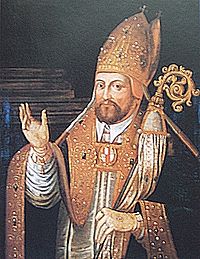
Back الأمير الأسقف Arabic Knyaz-Yepiskop Azerbaijani Княз-епископ Bulgarian Priñs-eskob Breton Príncep-bisbe Catalan Kníže-biskup Czech Fyrstbiskop Danish Fürstbischof German Princepiskopo Esperanto Príncipe-obispo Spanish
This article has multiple issues. Please help improve it or discuss these issues on the talk page. (Learn how and when to remove these messages)
|

A prince-bishop is a bishop who is also the civil ruler of some secular principality and sovereignty, as opposed to Prince of the Church itself, a title associated with cardinals. Since 1951, the sole extant prince-bishop has been the Bishop of Urgell, Catalonia, who has remained ex officio one of two co-princes of Andorra, along with the French president.[1][2]
- ^ "The constitution of the Principality of Andorra".
- ^ "Why is the President of France Co-Prince of Andorra?". Royal Central. 7 October 2019. Retrieved 9 November 2019.
The President of France, Emmanuel Macron, serves as Co-Prince of Andorra in addition to his duties as French President and is one of the few examples of a democratically elected leader serving in a royal capacity in another country. Since 2003, the other Co-Prince is the Catholic Bishop of Urgell from Spain, Joan-Enric Vives i Sicília. But how did the president and bishop become co-princes of another country? The answer lies in a political arrangement stretching back over seven centuries.
